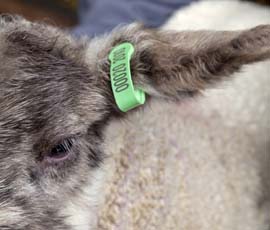Database set to ease sheep recording burden

Disease control and traceability in the food chain could soon be boosted by a new central database recording movements for sheep producers, Gemma Mackenzie reports.
At present sheep producers face penalties for movement recording errors, and no central database exists in England and Wales to store movement records for sheep despite the EU requirement for EID tags.
But a new movement recording database, which has the potential to link up producers, auction marts and abattoirs, could result in a more simplified, paperless system in the future.
Furthermore, if a disease outbreak were to happen, the database has the potential to allow for quick and accurate identification of animals that could have come into contact with infected animals, and farmers may be able to identify how their stock killed out at the slaughterhouse.
The National Livestock Management Database-Livestock Tracing (NLMD-LT) is based on Australian technology for cattle EID tracking, and allows farmers and Central Point Recording Centres (CPRCs) to upload movement data.
And according to NLMD-LT chairman Bill Madders, due to the fact more than 80% of UK sheep movements are made through CPRCs, farmers would be able to complete all their recording without having to manually read tags or purchase an EID reader.
The database is currently being trialled by East Sussex sheep farmer and livestock haulier Frank Langrish, and the team at Ashford Auction Mart, Kent.
Mr Langrish says: “After we were forced down the route of EID regulations, it soon became quite obvious that there had to be some way of recording this centrally otherwise the whole thing was a nonsense because with individual bits of paper, there’s no traceability.”
He says the system can be used as a flock register to record EID scanning and batch movements, while offering the option to manually enter individual ear tag numbers.
“The database has the potential to do a huge amount for the industry. It can do the bare minimum for ordinary movements and batch movements – the minimum required by Defra,” he adds.
“But going into the future, there is no reason why we cannot become a completely paperless system, where the farmer will not have to do anything apart from NLMD-LT. So when the markets and abattoirs are doing all the movements, all their recording will be done.”
With regards to disease outbreak, he warns the current ALM1 system would “leave us in the same position as we were in with foot-and-mouth disease” and says our current reliance on the export market is dependant on traceability.
“The beauty of that is that we won’t have to close down the rest of the country in the event of a disease outbreak at an auction mart. This system works pretty well in real time. So once the market has read tags, the information will go on the database the next morning so we can see where a lamb has gone to from the market.”
And for producers looking to find out how their animals killed out at the slaughterhouse, he says the system has the potential to link up the whole chain from farmer to auctioneer to abattoir.
He adds: “This is not a big brother thing because the ownership remains with the industry. It’s obvious the next step should be a move to a paperless system and because this is going to operate in real time, there’s the potential for this to be a cross-species database.”
Commenting on the system, auctioneer Peter Kingwill adds: “If we are going to have EID then it’s got to be worthwhile. It’s got to serve some purpose in the long term and at the moment we don’t have a database for the information that people are scanning.”
The database currently has the support of the Livestock Auctioneers Association, the Association of Independent Meat Suppliers, the British Meat Processors Association and Welsh Beef and Lamb Promotions.
Livestock Auctioneers Association executive secretary Chris Dodds says: “We support this because we believe that there is a need for a more appropriate, accurate and reliable recording system within the UK.
“And based on the Macdonald Report, I believe it would be beneficial and right for the industry to own the database and govern it.”
He says the upturn in the sheep industry is due to a buoyant export market, and warns that without a central recording database to aid enforcement officers when tracking animals, any disease outbreak could see this come to a standstill.
